Dec 1, 2020
How to Flush a PWC engine.
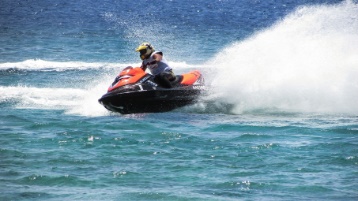
PWC Adventures
After a day of use, all personal watercraft (PWC) should be flushed, especially if used in silty or sandy areas. Flushing debris from the engine cooling system and exhaust will help prevent internal corrosion and keep those critical cooling passages running clear. Your PWC will be ready for operation when you are.
You want to continue to enjoy your PWC for years to come – Right?
Here’s how to flush a PWC engine.
Follow these 12 steps for flushing and cleaning a PWC.
This information is limited to an overview only. Remember, always find and follow the instructions for your model before flushing for the first time.
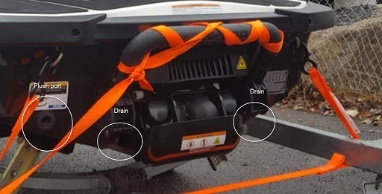
SeaDoo PWC Drain locations
- Locate the flush port(s). You will generally find flush ports on the transom or under the seat. It depends on your model.
- Attach the garden hose to the flush-fitting, but do not start the flow of water. That’s very important!
- Follow your owner’s manual. It may instruct you to idle for 90 seconds to 3 minutes.
- Idle the engine but do not rev the engine. Start the flow of water. Starting the water flow before starting the engine could result in water flowing into the engine through the exhaust system.
- After flushing, turn the water off and disconnect the hose. Now shut down the engine.
- Replace the plug.
Caution
Once done flushing, remember to turn the water off first. Some brands may instruct you to spike the throttle a few times before shutting down the engine to clear water from the exhaust.
Follow Your PWC Owner’s Manual.
These are general instructions. For flushing instructions specific to your model, consult the owner’s manual maintenance section. Can’t find the manual? Check the manufacturer’s website or visit the dealer.
On models with a closed cooling system (most late-model Sea-Doo PWCs), flush only the exhaust.
For other brands and models, flush the exhaust and the engine cooling passages. See the manual for details.
Follow the flushing instructions for your particular brand.
Failure to follow instructions may allow water to get into the engine, leading to corrosion and repairs.
You can flush the PWC while it is on a trailer or a lift, but it must be out of the water.
Want to clean the PWC further?
Find the flush port. Most brands have a flush port on the back of the hull. An alternative is under the seat or in the engine compartment. Check your owner’s manual for the proper location. Some flush ports accept the male end of a garden hose. Others use a snap-in adaptor that screws onto the garden hose. The adaptor would have been supplied with the PWC when it was new. If you don’t have any required adaptors for your model, you can get one from a dealer.
Now it’s time to clean the engine bay.
1. Remove the seat sections and any covers under it to see the engine.
2. Make sure the engine has cooled. Never rinse a hot engine.
3. Raise the bow of the PWC. Remove the drain plug from the hull so that rinse water can exit.
4. Using your water hose, rinse the cooled engine area and the bilge. It’s OK to use your thumb to make a spray of water. Don’t use a nozzle that puts out a lot of pressure. NEVER USE A PRESSURE WASHER. Too much water pressure can force water past the seals on electrical connectors.
5. Use an old towel or rags to wipe off all excess water from areas you can reach.
6. Spray down the engine components with a water-displacing lubricant (PWC dealers offer these or simply use WD-40). The oil will displace water left behind and leave a thin, anti-corrosive film.
How to store a PWC.
Store the PWC with the seat off to let the engine compartment dry completely. You can leave the bow up to facilitate draining. Remember to replace the drain plug before using the unit again. Leave yourself a reminder, like a cloth tied to the handlebar.
Conclusion
PWS has the answers for many of your dock, lift, and boating questions
Call Jerry at Pier & Waterfront Solutions (920-493-4404) for more information.
Where is Pier & Waterfront Solutions?
Located at 7325 St. Hwy 57, it’s 3 miles south of Sturgeon Bay and 1 mile past the intersection of Cty MM (heading north). Look on the right at the intersection of Idlewild Road and Hwy 57.
ARE WE OPEN?
Pier & Waterfront Solutions remains “open.”
We have implemented measures to guard the safety of our employees and visitors. At the same time, we are working to maintain the trusted service you expect.
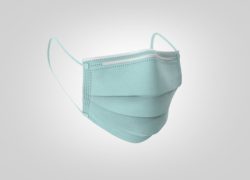
Please use face masks
PWS is conducting as much business as possible by email, text, or phone.
Site visits continue as usual. When in-person contacts are necessary, we follow “social distancing” guidelines as closely as possible.
Our display yard is OPEN
Our display yard is always open for you to examine at your leisure. All displays available for sale have a numbered, red tag on them. If you want more information or pricing, please reference that number when you call.
We provide estimates by email to make the process paperless, faster, and safer. Let’s get back to normal quickly.
What can YOU do to help us?
Please conduct as much business as possible via emails, messaging, and phone. When you see our crews on-site, please practice “social distancing.”
Call, message, or email us with any questions.
Thank you for allowing us to work with you safely.
Let’s all stay safe!
Jun 9, 2020
32 STEP CHECKLIST FOR A BOAT
This 32 step checklist for your boat will start your boating season off right.
Do you have spring fever? Are you itching to get your boat or jet skis back in the water? It’s been a L-O-N-G winter. Now it’s time to de-winterize your boat before taking it out for its first trip of the season.
Following a spring checklist, like the one below, can help prevent a host of problems. Skipping them could keep you out of the water later in the season.
We all know how fast storms come up on Green Bay. Don’t get caught unprepared. Make sure the boating season goes smoothly and safely.
HERE’S A SPRING CHECKLIST FOR A BOAT:
- Is your boat registered?
- Be sure to empty the old fuel and add fresh fuel.
- Are the fuel shut-off valves on the tank and at the engine working?
- Is your blower switch (if any)working?
- Recharge your battery and fill with distilled water, if needed.
- Secure the batteries in ventilated containers that are non-corrosive and liquid-tight.
- Fit non-conductive covers over the posts.
- Is the lower-case leak-free?
- Check the electrical system, including fuses, spark plugs, and wires.
- Inspect the propeller for damage.
- Is there any damage to the hull (blisters and cracks)?
- Flush the water tank.
- Replace any oil filters and lubricate all parts.
- Are all lines checked?
- Check the hydraulic steering system for leaks and fluid levels.
- Inspect the steering and throttle cables.
- Are all fire extinguishers charged?
- Is everyone familiar with how to operate them? Make sure that at least one can be reached from the helm or cockpit.
- Are life vests checked for wear, abrasions, weak or torn seams, secure straps, and buckles?
- Inspect the bilge pump, if any, for cleanliness and absence of obstructions. Check this frequently throughout the season.
- Check the engine compartment for excess water.
- Are the lights on your boat operational?
- Check the electrical cables and connections for loose, disconnected, or corroded conductors.
- Have you taken a boating safety course?
NOW YOU’RE READY TO GO.
- If you are towing your trailer to its launch point, you will also need to inspect it before your first outing. In particular, are the lights working properly?
- Be sure to tell someone responsible where you’re going.
READY TO LAUNCH
- Is the drain plug in place? You’d be amazed how often this happens.
- Follow all safe launching practices.
- Watch for kids in your path.
- Ventilate the bilge for several minutes before starting the engine.
- Watch the engine temperature and cooling system.
- Make sure everyone follows safe boating practices.
Now you’ve done the work – It’s time to enjoy the benefits!
Tell Your Friends & Family
Have friends or neighbors you believe should see this article? Email them this link – and Thank you!
Don’t Forget – Considering rip-rap for your shoreline? PWS is the place to contact!
Where is Pier & Waterfront Solutions?
Located at 7325 St. Hwy 57, it’s 3 miles south of Sturgeon Bay, and 1 mile past the intersection of Cty MM (heading north). Look on the right side, one mile north, at the next intersection (Idlewild Road and Hwy 57).
ARE WE OPEN?
During this time of uncertainty, Pier & Waterfront Solutions is staying “open.” We have implemented measures to ensure the safety of our employees and visitors. At the same time, we are working to maintain the trusted service that you have come to expect.
We are implementing these precautionary measures:
- Conducting as much business as possible by email, text, or phone.
- Site visits will continue but with limited in-person meetings.
- When in-person contacts are necessary, we will follow “social distancing” guidelines.
- Our display yard is always open for you to examine at your leisure. All displays have a numbered, red tag on them. If you want more information or pricing, please reference that number.
Is there More?
- Some employees will be working remotely, but they are always available by phone.
- Any employee with symptoms or illness is sent home.
- We continue to provide estimates and invoices by email to make the process paperless.
- Crew starting times are being staggered to limit social interactions.
- We keep the same crews together to limit cross interactions.
With these measures, we hope everyone will stay safe, and we will be back to normal operations soon.
What can YOU do to help us?
- Please conduct as much business as possible via emails, messaging, and emails. This step protects everyone involved.
- When you see our crews installing equipment, please practice “social distancing.”
Thank you for allowing us to work with you.
So – YES – WE ARE OPEN!
Please call, message, or email us with any questions.
Let’s all stay safe!
Contact:
Jerry @ (920) 493-4404 or Jerry@wisconsinpws.com – Commercial work & new/used Sales.
Dave @ (920) 905-2588 or Dave@wisconsinpws.com – Erosion control & shoreline work.
Jerry @ (920) 493-4404 or Jerry@wisconsinpws.com – Scheduling & Service work
Aug 13, 2019
NOTHING LASTS FOREVER – EVEN A LIFT CABLE
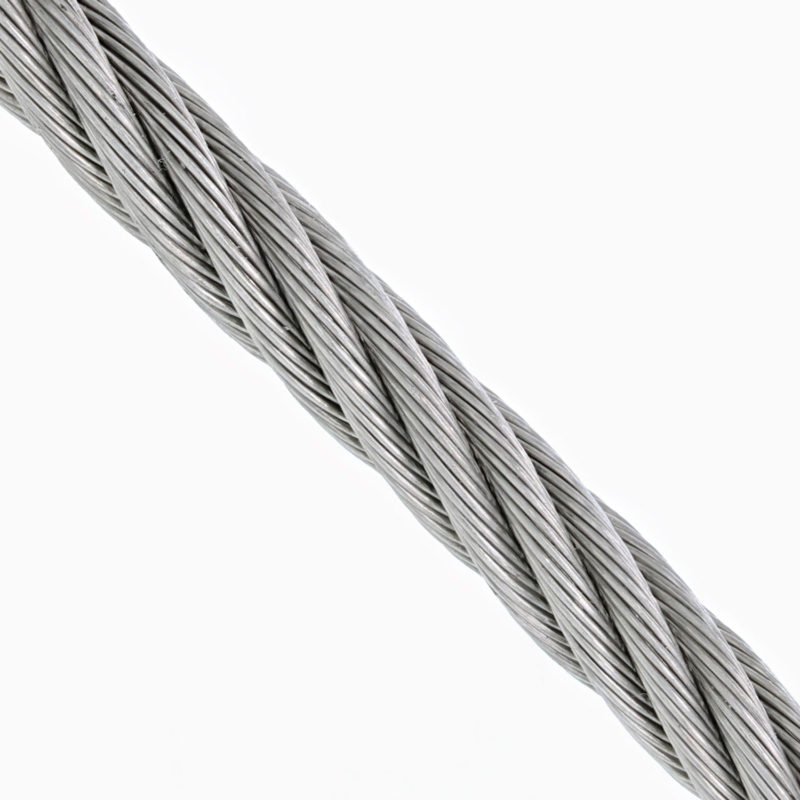
Typical Lift cable
That’s true! Your cables will eventually need replacement. When? That depends on you. If you’ve been around boat lifts for any length of time you have seen problems with boat lifts. Typical problems include corrosion, chafe, broken strands or kinks on the cables..
Let’s start by looking at the typical construction of a lift cable.


7 x 7 cable construction
The most common types are the 7 x 7 and 7 x 19 construction. As you can see they are not simply a wire hanging down that lifts your boat up. They are more complex than that.
The individual strands are wrapped together as shown Then they are wrapped again around a core.
HOW DO CABLES GET DAMAGED?
There are two types of wear:
External abrasion
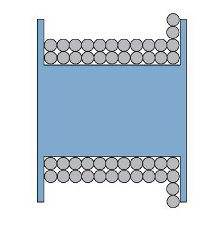
Typical Cable Stacking
This occurs when the cable bends around the winch drum and lift pulleys. On the winch drum, they rub against the adjoining wire or the drum sides. This rubbing causes wear on the external strands which will eventually wear through the individual stands.
If the cable doesn’t wrap properly, it starts to stack on the side of the winch drum. When the cable eventually slips off the “stack”, even though it is only dropping 1/4″ to 1/2″, the resulting noise shocks anyone nearby. It was under hundreds of pounds of pressure from the boat. This situation is usually caused by misalignment of the winch drum or a poorly threaded situation.
New ShoreMaster winches are attached with a complete housing around the upright post which prevents this from happening due to winch misalignment. More on this later in this discussion.
Internal abrasion
Internal abrasion occurs whenever strands work against each other under load. Each time a boat is raised or lowered over a winch drum, there is internal wear. Each strand of wire in the winding is moving at a slightly different speed. Abrasion of the strands is the result. When you lose too many strands, you lose a lot of strength. This condition cannot be eliminated but it can be controlled by using the proper size winch drum and pulleys.
A point often overlooked – internal abrasion and the resulting corrosion or rust in a galvanized cable, can be hidden and may not show visible damage. A cable like this may sometimes fail without prior warning.
ASSUMING IT IS WELL CARED FOR, HOW LONG SHOULD IT LAST?
Experts say that to be safe, replace a galvanized cable every two years. All things being equal, stainless wires will last longer-up to twice as long. But don’t rush out and try to change all your cables to stainless. Galvanized cable has its place on your lift. For one, they are stronger than stainless steel and can bend easier around the pulley and winch drum.
An improperly positioned boat may send your boat into the water. See https://wisconsinpws.com/boat-lift-safety-updated/ for more information.
When in doubt, replace the cable. Trying to squeeze another year out of the cable isn’t worth the risk of dropping your boat or personal injury.
COMMON PROBLEMS WITH BOAT LIFT CABLES

Frayed Boat Lift Cable
Chafe or fraying – are those fine broken strands that poke or cut your hands when you slide your hands along the cable. If you catch your clothes when they brush against a cable you have “chafe” or fraying.
Chafe may be the result of faulty sheave alignment or improper drum winding.
Lowering a lift rack without any weight on it, especially on a small lift like a PWC lift, may also result in a “backlash.” This is discussed later.
Note: Be aware that most winches require at least 50 lbs of weight to work correctly.
BROKEN STRANDS

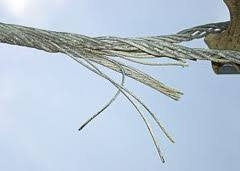
Broken Strands
Broken strands are very dangerous. Boat lifts with this type of damage should be replaced immediately.
CORROSION
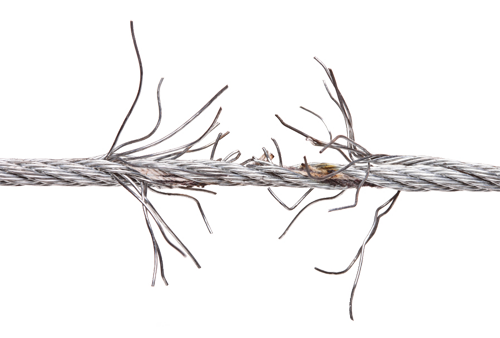
Corroded & Frayed Boat lift Cable
Corrosion presents a significant problem for galvanized cables. When the protective layer of galvanizing wears through as discussed above, corrosion will begin. Corrosion may not always be visible to the naked eye. The first time you become aware of the corrosion could be when the cable breaks.
Corrosion may also occur “inside” the cable with little or no external evidence of the damage as discussed above. Any cable showing external signs of rust or corrosion needs replacement.
BACKLASH
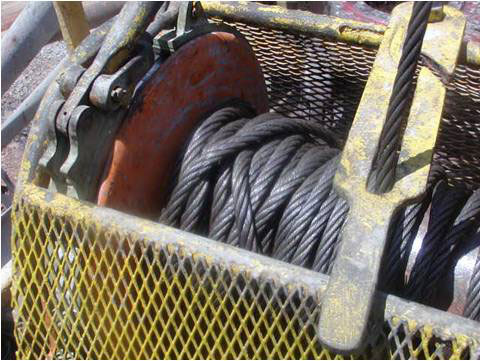
Boat lift cable backlash
When a lift is lowered to the bottom and the winch continues to move the result will be a Backlash. If there is insufficient tension on the cables they will “spring” in every direction on the winch drum. When you retighten the cable, the loose cables become snarled and can wrap up like a backlash in a fishing reel.
WHAT IF I EXPERIENCE A BACKLASH?
Whenever a cable experiences a backlash DO NOT use your bare hands to repair the problem (chafe). You won’t soon forget this if it happens to you. People have also lost fingers when a cable snaps back onto a winch drum. Make sure you wear leather gloves and keep tension on the cable at all times. Keep your hand at least 12″ from the winch to prevent entanglement.
When you experience a backlash, lower the boat into the water to prevent the cables from interleaving further on the drum.
Never use bare fingers or pliers to align the cables. As always, carefully handle it to avoid breakage of the wire strands.
Next, unwind the winch while keeping tension on it. Do this until you see the bottom layer on the drum. Re-wrap the cable onto the winch drum while maintaining tension. Rewind it in even layers. Be sure to close any gaps between the cable on the winch drum.
Finally, it is time to return your boat to the lift to raise it, making sure the cable continues to wind smoothly. If the problem persists, call your lift dealer (that’s PWS)
DID YOU REMEMBER THE WIRE “MEMORY”?
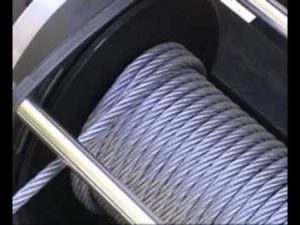
Properly wound cable
“Memory” allows the cable to play out and rewind onto the drum in a neat pattern. The wire must wind in a set pattern. Loose that “memory” and misalignment occurs which will cause the cable to turn against the side of the winch drum.
Maintain tension at all times to prevent the cable from interleafing with the windings in a lower layer. Fill in each layer completely, leaving no gaps.
WHAT’S COMING UP NEXT WEEK?
Next week we give you more information about boat lift cables and what you can do to lengthen their life.
Remember
Pier & Waterfront Solutions (PWS) specializes in all ShoreMaster docks, lifts, and accessories.
We are located in the center of Door County at 7325 St Hwy 57, just south of Sturgeon Bay at the intersection with Idlewild Road. Our staff looks forward to serving all of your waterfront needs.
Call Jerry at 920-493-4404 or Email Jerry@wisconsinpws.com for more information.
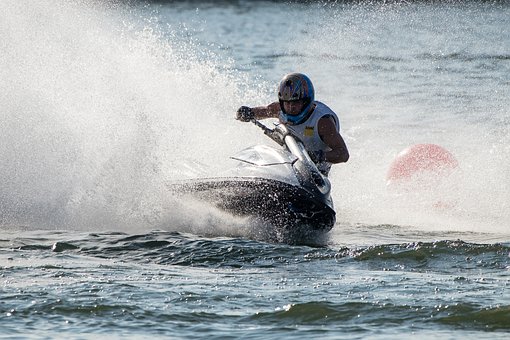
Jul 23, 2019
JET SKIS and THE LAW
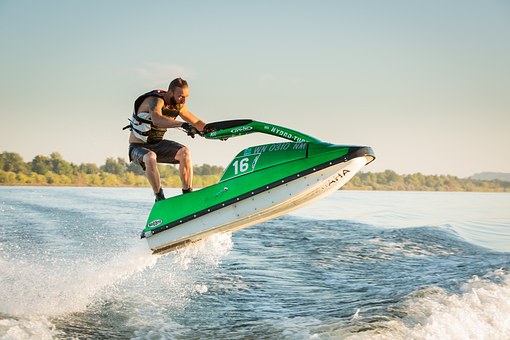
Stand-up PWC
State & Federal law has a lot to say about how you operate your Jet Ski.
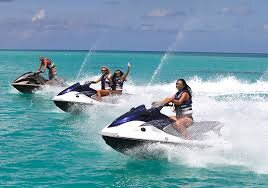
Keep 100 feet apart
Many people don’t realize there are legal ways and some NOT so legal ways to operate a PWC or jet ski.
Beyond the usual title and registration that everyone expects, there are specific laws that apply to PWC’s.
Who can operate a jet ski?
In Wisconsin, a person younger than 12 years of age, may not operate a PWC or jet ski.
12-15 years olds may operate a pwc ONLY If they have completed a boating safety course. The Wisconsin DNR must accept the course. Sorry, you can’t substitute parental supervision for this course.
A person at least 16 years old may operate a PWC only if they have completed an accepted boating safety course.
Were you born before Jan 1, 1989?
You are exempt from the course requirement.
No one under 16 years old may rent or lease a PWC.
Remember if you have taken the proper courses, you must carry a copy of the certificate with you and make it available to law enforcement officers when requested.
In addition to the U.S. Coast Guard, Wisconsin conservation wardens, county sheriffs, and municipal police enforce the laws.
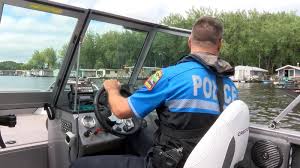
Boat Safety Rule #3- Don’t get a visit from him
Just like driving a vehicle, it is illegal to:
- refuse to follow the instruction of a law enforcement officer.
- A pwc operator must slow to “no-wake” or “slow” and give way to a patrol boat if it’s emergency lights are on or if they signal you to stop.
- You must stop when requested or signaled by a law enforcement officer or patrol boat.
- Furthermore, you must reduce speed to “slow” or “no-wake” and stay at least 100 feet from a patrol boat with its emergency lights activated. It’s similar to pulling into another lane when you see an emergency vehicle on a roadway.
You must have the legally required equipment on board at all times including:

Boat Safety Rule #1- Everyone needs one
- PFD (personal flotation device or life jackets) even on canoes and kayaks.
- Kids under 13 must WEAR their PDF while underway on a pwc on federally controlled waters.
- EVERY person on a pwc MUST wear an approved PDF.
- You must wear the proper size PDF, and it must be in good and serviceable condition. No tears, rips, broken straps, or snaps.
Do I need a sound-producing device (Horn) on a PWC?
No! UNLESS you are on federally controlled waters like Lake Michigan.
Are we done? Not Really!
It is against the law to operate a vessel in a negligent or reckless manner such as in a manner that causes danger to life or limb.
Here are some examples:
Operating a vessel within 100 feet of the shoreline, a raft or pier at speeds higher than “no-wake” or “Slow.”
Jumping the wake of another vessel that is towing someone;
Operating a pwc within an area which is marked off for swimming;
Weaving your craft through congested waterways;
Causing hazardous wave or wake conditions while passing another vessel;
Steering toward another object or person and swerving at the last moment; or chasing, harassing or disturbing wildlife.
Overloading your vessel
If you have a pwc rated for two people, that is the maximum number you can have on it at any time regardless of weight or age.
These are just some of the laws you must follow.
Think of operating a vessel like you would a car. If it’s not legal in a car or truck, don’t try it on the water. Example – Do NOT drink and drive!!
Visit the DNR website at www.dnr.wi.gov and enter “boat safety” to find acceptable boating courses. Also, look for https://dnr.wi.gov/files/pdf/pubs/le/le0301.pdf
To read part one of this series go to https://wisconsinpws.com/pwc-jet-ski-users-guide
Keep us all safe, and we’ll all enjoy the water more on a PWC.
Do you have a friend that might be interested in this post? Please forward it to them.
Pier & Waterfront Solutions
PWS is located at 7325 St. Hwy 57. That’s 1 mile North of County MM (Hwy 42) and 3 miles south of Sturgeon Bay at the Idlewild Road intersection. Or – for more information, you can call Jerry @ 920-493-4404.
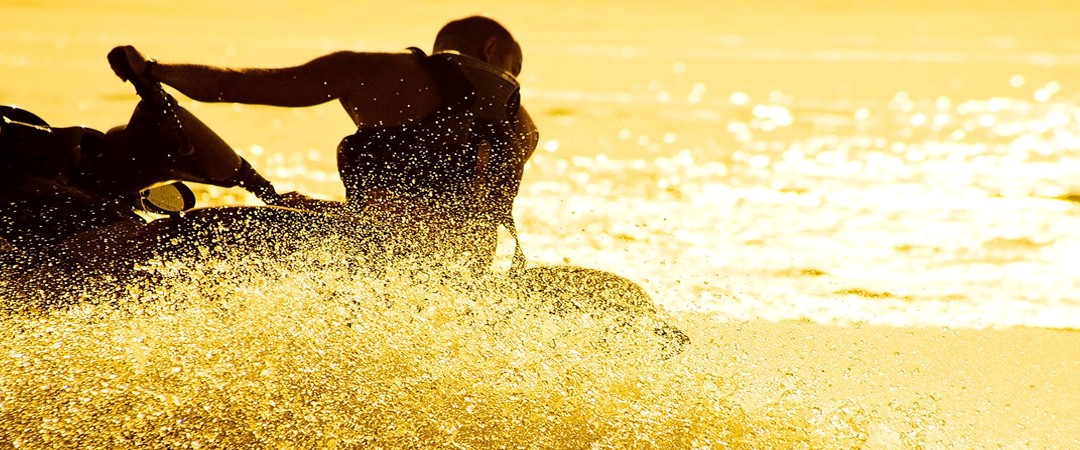
Jul 16, 2019
Are there different Styles?
Yes, they come in two styles: Stand-Ups and Sit-Downs.
Both styles use water to create thrust to provide propulsion. The propulsion also controls the steering. Therefore, the motor has to be running to use either or both features.
Stand-up jet skis require a great deal of balance as any experienced operator will tell you. I suggest that your first jet ski ride happens on a sit-down unit.

Stand-up PWC
Stand-ups are not easy to control, and a strong wave can easily throw you off balance. That means you are going for a swim, whether you want to or not!
You have greater control on a sit-down from a slow idle to full speed ahead. The sit-down type is more comfortable to ride, and, if maneuvered correctly, you don’t even have to get wet! But who wants that! The wetter you are, the better.
Before your first trip on a PWC (here comes the checklist)
Jet ski riders do get injured; which makes it important to familiarize yourself with the specific watercraft you’ll be riding.
Injuries?? From what?! How about getting thrown off your ride for one. It’s very easy to do when you are turning at full speed. It’s exciting also.
Despite this, safety should be your first concern – both for you, your passenger, and people in the immediate area.
Know your machine’s controls and capabilities! Know your abilities as well. Different brands will have different controls, so make sure you know what’s the throttle and what’s the emergency shut off. Throwing the wrong switch could be very embarrassing (and dangerous).
Make sure you have enough fuel and all the proper safety equipment too.
My First Jet Ski Ride – what do I need to take with me?
The U.S. Coast Guard considers a PWC to be a Class A vessels. Therefore you must follow all rules and regulations for boats under 16 feet. Before that ride, make sure you have the required safety equipment. Not only to satisfy the Coast Guard but for your own safety as well.

Boat Safety Rule #1- Everyone needs one
Wear Coast Guard-approved life jackets/PFDs at all times. It’s a law that you and passengers can live with! Dress appropriately in a wetsuit, if possible. Wear simple feet protection and don’t forget eye protection. In most cases, your face will be pelted with stinging water while on your ride.
Check if your state requires a license while operating a PWC. If so, you may have to take a jet ski safety course to qualify for your license. The course may make you eligible for a PWC insurance discount too! Carry the proper documentation, such as vessel registration. It’s wise to have some form of identification also in case you are incapable of responding.
Secure a Coast Guard-approved fire extinguisher onboard if possible.
What else should I have?
Carry an audible signaling device, such as a whistle or horn. Don’t forget to check your fuel gauge. You will forget the time (a good thing for most of us) but bad if you run out of daylight or fuel! The driver of the jet ski must wear a lanyard around their wrist, which is attached to the key in the ignition. It’s known as a kill switch cord. The kill switch will turn off the engine in case the driver gets thrown off the unit. Some models may shut down if the throttle is released (as you go flying through the air).
Back at the dock, don’t forget to remove the cord! It stops any unauthorized use, whether preventing theft or safely securing the jet ski from daring young teenage riders.
What do I do if I fall off?
No doubt you will fall off, so here’s what you do.
Don’t panic. Re-boarding is a breeze if you follow these steps!
1. Turn the unit over from the side but watch the steering. It might hit you if you’re not careful.
2. Swim to the stern (back) to re-board. Re-boarding from the side may cause the unit to flip over, right on top of you.
3. There are handles or straps on the back of the seat. Use them to pull yourself up.
4. Move forward to the seat and don’t forget to re-attach the safety lanyard.
5. Of course, you were wearing a life preserver all this time.
Riding a Jet Ski with Passengers
It’s no surprise you will become very popular with your friends and family. They all want to ride on, or better yet, drive it themselves. If so, there are some extra steps to follow:
Carry only the permitted number of passengers that the jet ski allows. Don’t pile the kids on even for a slow speed ride. Make everyone wait their turn. Don’t forget there is a weight limit also. You must follow that limit.
All passengers must sit behind the driver.
Whenever the jet ski’s moving, have passengers secure themselves onto the seat straps provided. They will be the first to get thrown off the unit in a sharp turn at high speeds.
Make sure no one places their feet in the water while you are moving.
Demonstrate the basics of driving a jet-ski to all passenger’s. Why? If the driver becomes injured, it could come in handy! Make sure they know how to re-board if they are thrown off and you are injured.
Lookout for blindspots while turning.
Riding jet skis is a fun-filled summer pastime, but only if you do it correctly and safely. It takes practice. With practice, you’ll be ready when your time comes.
Be safe but have fun. Get out there and ride!
Next week we will talk about jet skis and THE LAW! https://wisconsinpws.com/jet-skis-the-law/
Do you have a friend that might be interested in this post? Please forward it to them.
Pier & Waterfront Solutions
PWS is located at 7325 St. Hwy 57. That’s 1 mile North of County MM (Hwy 42) and 3 miles South of Sturgeon Bay at the Idlewild Road intersection. Or – for more information, you can call Jerry @ 920-493-4404.
























